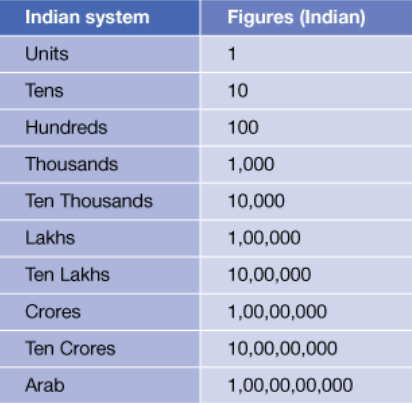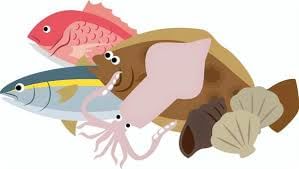The fish Tale - 1 Class 5 Worksheet Maths
Q1: Choose the correct answer from the brackets.
(i) One crore = ____ lakhs.
(Thousand, Hundred, Ten)
Ans: Hundred
1 crore =100 lakh, which can also be written as: 1 crore = 10×10 lakh.
The following chart shows how the number of zeroes increase as you move keep going higher.
Tip: There are seven zeroes in 1 crore!

(ii) If 1 kg of sardines cost 40 rupees, the cost of half kg is ____. (30, 20, 10)
Ans: 20 rupees
Given: The cost of 1 kg sardines = 40 rupees.
To find: The cost of 1/2 kgSo, to find the cost of 1/2 kg, we divide the cost of 1 kg by 2:
Cost of 1/2 kg of sardines = 40/2
=20 rupees
(iii) If the speed of the boat is 25 km/hour, then the boat goes ____km in 3 hours.
(25, 50, 75)
Ans: 75 km
Given: Distance given in one hour = 25 km
To find: Distance covered in 3 hours
If the boat covers 25 km in 1 hour, to find how far it goes in 3 hours, we multiply the distance for 1 hour by 3:
Distance in 3 hours = 25 km x 3 = 75 km

(iv) The numeral for one crore is expressed as ____. (10000000, 1000000, 100000)
Ans: 10000000
There are seven zeroes in 1 crore.
(v) The number of zeros in one lakh is ____. (5, 6, 7)
Ans: 5 zeros
One lakh is written as 1,00,000.
(vi) When fresh fish is dried it becomes 1/3 of its weight. We dry 6 kg fresh fish to get ____ kg dried fish. (1kg, 2kg, 3kg)
Ans: 2 kg
It is given that when 1 kg fish is dried, it becomes 1/3 of its weight. By using the unitary method, we know that:
When 6 kg fish is dried, it will result into:
6 x 1/3 or 6/3
= 2 kg

(vii) If a log boat travels at a speed of 4 km in one hour, it will take ____ hours to go a distance of 10 km. (2 hours 30 minutes, 3 hours, 2 hours 15 minutes)
Ans: 2 hours 30 minutes
By using unitary method:
4 km can be covered in = 1 hour
1 km can be covered in = 1/4 hours
10 kms can be covered in = 1/4 x 10
=2.5 hours or 2 hours 30 minutes
(viii) The speed of a motor boat is 20 km/hour. The distance covered in three and a half hours is____
(60 km, 70km, 75 km)
Ans: 70 km
Given: Speed of the motor boat = 2 km/hr. This means that the distance a boat can cover in 1 hour = 20 km.
Using unitary method:
Distance covered in 3.5 hours = 20 x 3.5
= 70 km
(ix) One –fourth of 100 rupees is____. (25, 50, 75)
Ans: 25 rupees
One fourth of 100 rupees = 1/4 x 100
= 25 rupees.
(x) If 1.5 kg of apples costs 90 rupees, what is the cost of 0.75 kg of apples? (45, 60, 30)
Ans: 45 rupees
First, find the cost per kg by dividing the total cost by the weight:
Cost per kg = 90 ÷ 1.5 = 60 rupees/kg.
Now, to find the cost of 0.75 kg:
Cost of 0.75 kg = 60 × 0.75
= 45 rupees.
Q2: 1 kilogram (kg) = 1,000 grams (gm)
Convert to the units shown.
(i) 0.06 kg = ____g
Ans: 60 g
1 kg = 1,000 g
So, 0.06 kg = 0.06 x 1,000 g = 60 g
(ii) 8.3 kg = ____g
Ans: 8,300 g
1 kg = 1,000 g
8.3 kg = 8.3 x 1,000 = 8,300 g
(iii) 0.49 kg = ____g
Ans: 490 g
1 kg = 1,000g
0.49kg = 0.49 x 1,000 = 490 g
(iv) 0.2 kg = ____(g)
Ans: 200 g
1 kg = 1,000 g
0.2 kg = 0.2 x 1,000 = 200 g
(v) 23 g = ____ (kg)
Ans: 0.023 kg
1 kg = 1,000 g
23 g = 23 / 1,000 = 0.023 kg
(vi) 7.4 g = ____ (kg)
Ans: 0.0074 kg
1 kg = 1,000 g
7.4 g = 7.4 / 1,000 = 0.0074 kg
(vii) 0.07 kg = ____ (g)
Ans: 70 g
1 kg = 1,000 g
0.07 kg = 0.07 x 1000 = 70 g
(viii) 5.5 kg = ____(g)
Ans: 5,500 g
1 kg = 1,000 g
5.5 kg = 5.5 x 1,000 = 5,500 g
(ix) 80 kg = ____(g)
Ans: 80,000 g
1 kg = 1,000 g
80 kg = 80 x 1,000 = 80,000 g
(x) 4.6 g = ____ (kg)
Ans: 0.0046 kg
1 kg = 1,000 g
4.6 g = 4.6 / 1,000 = 0.0046 kg
Q3: Answer the following questions.
(i) Write the number one thousand. Now write one hundred thousand. So how many zeroes are there in the number one lakh? Easy, isn’t it?Ans: One thousand = 1,000.
One hundred thousand = 1,00,000
There are five zeroes in one lakh.
(ii) There are about two lakh boats in our country. Half of them are without a motor. What is the number of boats with a motor? Write it.
Ans: Total number of boats in the country = 2,00,000
So, number of boats with motor = 2,00,000 X 1/2 = 1,00,000 = 1 lakh
(iii) About one fourth of the boats with a motor (given in the answer above) are big machine boats. How many thousand machine boats are there? Come on, try to do it without writing down.
Ans: Number of motor boats = 1,00,000
Number of big machine boats =One-fourth of motor boats =1,00,000 X 1/4
= 25,000
So, there are 25,000 machine boats.
(iv) Where have you heard of a crore? What was the number used for?
Ans: I have heard of population of India in crores. It is more than 100 crores.
(v) Try writing the number one crore. Write number of zeroes in it. Don’t get lost in all the zeroes!
Ans: One crore = 1,00,00,000.
There are seven zeroes in one crore.
|
31 videos|192 docs|41 tests
|
FAQs on The fish Tale - 1 Class 5 Worksheet Maths
| 1. What is the main theme of "The Fish Tale"? |  |
| 2. Who are the key characters in "The Fish Tale"? |  |
| 3. What moral lesson can be derived from "The Fish Tale"? |  |
| 4. How does the setting influence the story in "The Fish Tale"? |  |
| 5. What are some common interpretations of the fish as a symbol in the story? |  |






















